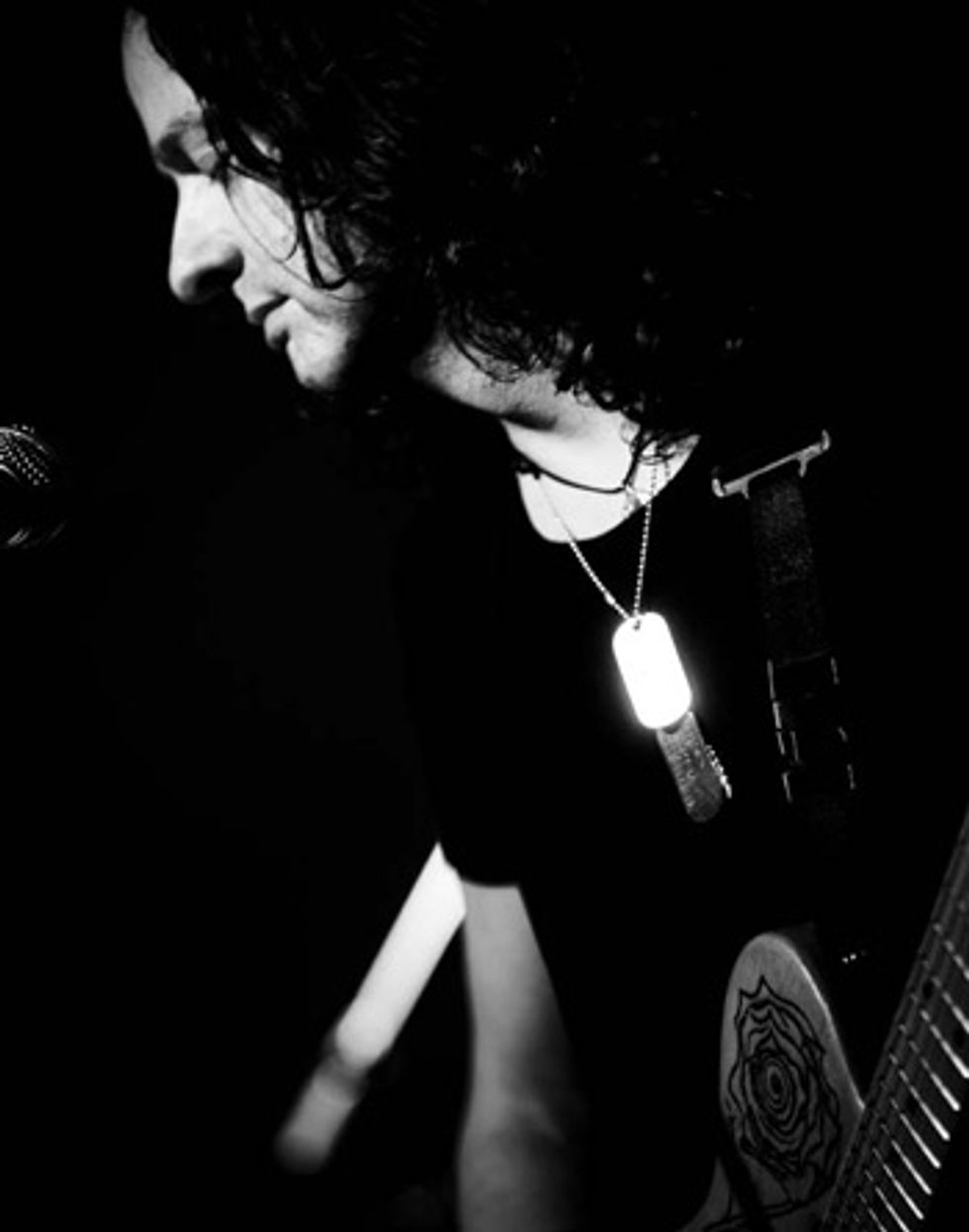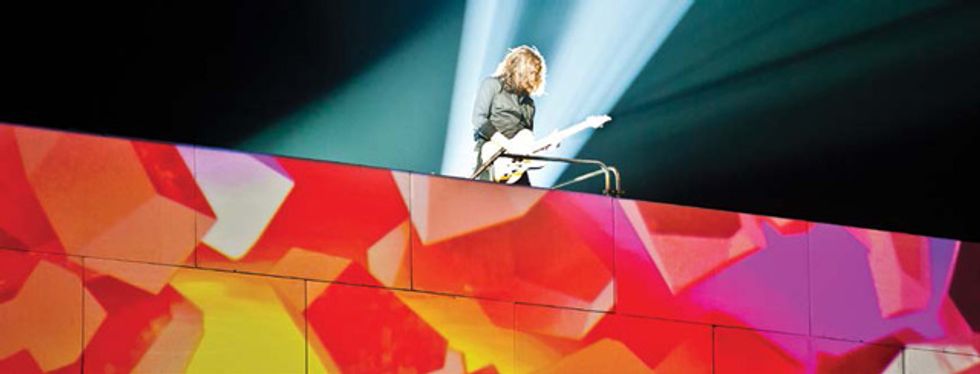U.K. guitar hero Dave Kilminster talks about the ups and downs of solo albums, explains why he shuns most effects, and reveals how an unusual altered tuning is the centerpiece of his next album.

Photo by Simone Cecchetti
“I thought it was about time I stopped helping other people with their careers and got on with mine,” laughs Dave Kilminster about the motivation behind his 2007 debut album, Scarlet. After playing the role of über-sideman to a list of rock royalty that includes John Wetton, Keith Emerson, and most notably Roger Waters, Kilminster stepped out on his own with a tight collection of tuneful originals. During a break from Waters’ seemingly never-ending touring production of The Wall, Kilminster decided to revisit Scarlet. “When I finally got time to go back and look at it, I realized it deserved a lot more. So I went back in the studio and had a fiddle with it with a good friend of mine, Jamie Humphries, who is a great guitarist, and we ended up with The Director’s Cut.”
Sonically, the original version was missing something. The drum sound didn’t match Kilminster’s vision, and that led him to strip away some unessential elements and make the album sound more focused. “It was almost like there was a great sounding album underneath all this crap on top of it,” says Kilminster. “When I took the recording to Jamie, he made the drums sound like they should have in the first place. Then I did a few extra vocal harmonies. We were rushed in those initial sessions and I wasn’t particularly confident about singing, but this time Jamie just told me to go for it.”
The entire Scarlet experience gave Kilminster what ended up as a grad school education in following your creative muse and not settling for a lackluster sound in the final product. “You learn a lot by just throwing yourself in the deep end and that’s what I did,” recalls Kilminster. “Everything just took a little longer than I wanted it to.”
But not everything about Scarlet was a total miss. Very early on in the process, after a day of jamming in preparation for a Keith Emerson tour, Kilminster decided to skip the traditional building-block method of recording an album and focus instead on capturing the trio’s live feel. “I listened to that recording when I was going home and realized this is what’s missing—three people playing together live.”
That in-the-room-energy permeates The Director’s Cut, from the slinky funk-rock groove of “Static” to the Zep-meets-power-pop feel of “Liar, Liar.” The latter features some of the most fluid, shred-tastic soloing that Kilminster has ever done.
“I’m not a big fan of effects on overdriven sounds. When I do the ‘Comfortably Numb’ solo with Roger, I put on this
chorus to try and make it sound a bit more like the record, and I always hate doing it,” says Kilminster. Photo by
Ronald Santerre
Even though the production might have gotten a little out of hand, Kilminster’s guitar rig was about as simple as you can get. His main tools were a black ’74 Fender Telecaster and a limited edition Vox AC30.
“I wasn’t quite sure what we were going for—maybe I was still in my Jeff Buckley phase, to be honest,” says Kilminster. “Later when I went back, I decided that the clean bits weren’t clean enough and the overdriven bits weren’t heavy enough.”
That desire for more dynamics led Kilminster to shun many effects—especially for his dirtier sounds. “I’m not a big fan of effects on overdriven sounds. When I do the ‘Comfortably Numb’ solo with Roger, I put on this chorus to try and make it sound a bit more like the record and I always hate adding it.”
Kilminster’s usual recipe for stellar tone involves a great guitar and a great amp. Even a delay doesn’t interest him. “The first time I ever used a delay on a guitar solo was when I started playing with Roger. It wasn’t something I particularly wanted to do.”
With the entire Scarlet experience behind him, Kilminster began working on his next solo album this past December, but the opportunity to participate in the “12-12-12” Hurricane Sandy benefit at Madison Square Garden conflicted with his recording dates. While preparing for his new solo project, Kilminster took some radical steps to reinvigorate his writing and playing.
“Why is it that most guitarists write their best material in their early-to-mid 20s? I wonder if it’s to do with the fact that you are still learning the instrument. You’re still messing around and not really quite sure what you are doing and you stumble across these great sounding things. How could I unlearn the guitar quickly?”
The notion of “unlearning” the guitar inspired Kilminster to explore an entirely new tuning. After a few tweaks of the tuning pegs, he landed on C–G–D– G–A–D, a tuning firmly in the DADGAD family, but with some added low-end thump.
Dave Kilminster's Gear
Guitars
1974 Fender Telecaster, Suhr Custom “Rose”
Amps
Vox AC30 Limited Edition, Brunetti Mercury
Effects
Suhr Riot, Boss CE-5 Chorus Ensemble, Ernie Ball 6166 volume pedal, Eventide TimeFactor, Boss TU-3 chromatic tuner
Strings, Picks, and Accessories
D’Addario EXL110 .010-.046 strings, Dunlop Gator Grip 2.0 mm picks
“I just thought this was so exciting to come up with a tuning where I had no idea what I was doing,” says Kilminster. The original idea was to use this new discovery for the main rhythm parts, but then move over to the comfortable surroundings of standard tuning for the solos, but Kilminster hasn’t yet made the final decision. “I could be totally shooting myself in the foot with this. Do I really want to relearn all my modes, scales, and arpeggio shapes?”
With a summer European tour with Roger Waters on the books, Kilminster is hoping to not only finish a new solo album, but also pair up with master shredder Guthrie Govan for a duo album that will certainly grab the attention of guitar nerds on both sides of the Atlantic. “I’ve actually written some tunes for that because I really, really, really want to do it,” he says. “Hopefully, if time permits, we could be in the studio around October. When we play together there’s this kind of ESP thing that happens and it’s so much fun. It needs to get down on vinyl, or plastic, or whatever.”

